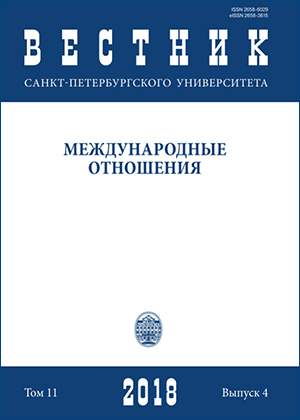From the heartlands of jihadism: The politics of chaos in Afghanistan
DOI:
https://doi.org/10.21638/11701/spbu06.2018.401Abstract
This article examines the phenomenon of jihadist groups operating in the Afghanistan-Pakistan borderlands and argues that the political chaos that reigns in Kabul is contributing to the growth of jihadism in Afghanistan. The administration of Kabul is losing its grip on the security situation and Afghanistan is once again on the brink of an abyss. The future of various jihadist groups, be they the Taliban, ISIS, Tehrik-e Taliban Pakistan operating on Afghan soil or other smaller groups, appears promising. On the other hand, the prognosis for the Afghanistan-Pakistan borderlands and the civilian populations living in the rugged and restless region appears bleak. The vicious cycle of violence continues and the entrenched jihadist groups revel in the chaos caused by the failure of central governments on both sides of the border to establish the rule of law and provide services for the local populations. It appears that the borderlands that have always been beyond the control of central governments will continue to be ungoverned spaces for a long time to come.
Keywords:
Afghanistan, jihadism, Taliban, ISIS, Pakistan
Downloads
References
Dalrymple W. Return of a King: The Battle for Afghanistan 1839–1942. New York, Alfred A.Knopf, 2013. 560 p.
Parham S. Controlling Borderlands? New Perspectives on State Peripheries in Southern Central Asia and Northern Afghanistan. The Finnish Institute of International Affairs, FIIA Report 26, 2010. Available at: https://storage.googleapis.com/upi-live/2017/01/upi_fiia_26_parham_web.pdf (accessed: 26.10.2018).
Mansfield D. A State Built on Sand: How Opium Undermined Afghanistan. London, Hurst & Company, 2016. 352 p.
Junger S. War. New York, Twelve, 2011. 320 p.
Brown V., Rassler D. Fountainhead of Jihad. The Haqqani Nexus 1983–2012. London, Hurst & Co, 2013. 320 p.
Keesing H.G. Faith Unity Discipline: The ISI of Pakistan. London, Hurst & Company, 2016. 309 p.
International Crisis Group. Afghanistan’s Insurgency after the Transition. Asia Report N 256, 12 May 2014. Available at: https://www.crisisgroup.org/asia/south-asia/afghanistan/afghanistan-s-insurgency-after-transition (accessed: 26.10.2018).
Ruttig T. Daesh and Taleban in Afghanistan. Oxford Analytica Daily Brief, 17 November, 2015.
Giustozzi A., Mohammad A. The National Unity Government and the Re-Shaping of Political Coalitions in Afghanistan. Center for Research and Policy Analysis, Kabul, 2018. Available at: https://www.crpaweb.org/single-post/2018/01/10/The-National-Unity-Government-and-the-Re-Shaping-of-PoliticalCoalitions-in-Afghanistan-Antonio-Giustozzi-Ali-Mohammad-Ali (accessed: 26.10.2018).
Ruohomäki O. Afghanistan’s Uncertain Future: Fragmented Realities and Geopolitical Fault Lines. The Finnish Institute of International Affairs, FIIA Briefing Paper 202, 2016. Available at: https://storage.googleapis.com/upi-live/2017/04/bp202_afghanistan_s_uncertain_future.pdf (accessed: 26.10.2018).
BBC. Taliban Threaten 70% of Afghanistan, BBC Finds. 31.01.2018. Available at: https://www.bbc.com/news/world-asia-42863116(accessed: 26.10.2018).
UNAMA. Afghanistan: Protection of Civilians in Armed Conflict — Annual Report 2017. United Nations Assistance Mission to Afghanistan, Kabul, 2017. Available at: https://unama.unmissions.org/sites/default/files/afghanistan_protection_of_civilians_annual_report_2017_final_150218.pdf (accessed: 26.10.2018).
Ruttig T. More Violent, More Widespread: Trends in Afghan Security in 2017. Afghan Analysts Network, Kabul, 2018. Available at: https://www.afghanistan-analysts.org/more-violent-more-widespreadtrends-in-afghan-security-in-2017/ (accessed: 26.10.2018).
Osman B. Descent into Chaos: Why did Nangahar turn into an IS hub? Afghan Analysts Network, Kabul, 2016. Available at: https://www.afghanistan-analysts.org/descent-into-chaos-why-did-nangarharturn-into-an-is-hub/ (accessed: 26.10.2018).
Clark K., Osman B. More Militias? Part 2: The proposed Afghan Territorial Army in the fight against ISKP. Afghan Analysts Network, Kabul, 2017. Available at: https://www.afghanistan-analysts.org/more-militias-part-2-the-proposed-afghan-territorial-army-in-the-fight-against-iskp/ (accessed: 26.10.2018).
Rashid A. Pakistan on the Brink. The Future of America, Afghanistan and Pakistan. London, Viking, 2012. 256 p.
Giustozzi A. Taliban and Islamic State: Enemies or Brothers in Jihad? Center for Research and Policy Analysis, Kabul, 2017. Available at: https://www.crpaweb.org/single-post/2017/12/15/Enemies-or-JihadBrothers-Relations-Between-Taliban-and-Islamic-State (accessed: 26.10.2018).
Ali O. Qari Hekmat’s Island: A Daesh enclave in Jawzjan? Afghan Analysts Network, Kabul, 2017. Available at: https://www.afghanistan-analysts.org/qari-hekmats-island-a-daesh-enclave-in-jawzjan/ (accessed: 26.10.2018).
Downloads
Published
How to Cite
Issue
Section
License
Articles of "Vestnik of Saint Petersburg University. International relations" are open access distributed under the terms of the License Agreement with Saint Petersburg State University, which permits to the authors unrestricted distribution and self-archiving free of charge.




